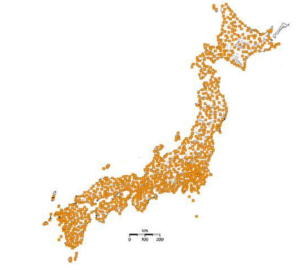Utilising quantum-tunnelling for a robust, highly sensitive, inexpensive new seismometer
Around 500 major earthquakes have killed over 400,000 people in the 21st Century, disproportionately in developing nationals, and around the famous ‘ring of fire’.
You cannot do anything to prevent an earthquake.
But if you can detect them sufficiently early, you can act, to save lives.
This is possible because earthquake waves move at a finite speed, and because there are early warning signals (faster longitudinal waves) before the damaging (slower, transverse) waves arrive.

The Japanese earthquake detection network averages one seismometer every 20km
Proof of this is in Japan, where a comprehensive network of seismometers allows fast earthquake response to save lives and prevent infrastructure damage.
In fact the extensive Japanese network connects one seismometer about every 20km.
This intensive network allows the system to detect incoming primary earthquakes waves and slam the brakes on a 300kph train, bringing it to a complete halt before the damaging earthquake waves arrive.
But that network is expensive. A much smaller network in only three states of the US cost that country US$100m to install, and US$40m in annual maintenance.
Such investment isn’t possible in less affluent developing nations, such as Indonesia, which as a consequence of geology experiences over a thousand earthquakes a year of at least moderate strength (>4.0), and over a hundred > 7.0 in the last century.
Current seismometer technology is expensive, and is based on classical, centuries-old principles
We envisage making seismometers much more accessible for both developing and developed nations, saving lives via early detection, and improving understanding of large-scale and small-scale geology.

Not meters, but quakes. Indonesia on the Ring of Fire experiences over a thousand earthquakes over 4.0 each year.
The Quantum Earthquake Detector (Q.E.D.) would utilise the phenomenon of quantum tunnelling to build a seismometer that is cheaper and potentially more sensitive than current technology.
Quantum tunnelling is where an electrical current can flow across an insulating gap. A phenomenon that does not happen in ‘classical’ physics, but is very well established at very small (atomic and subatomic) scales.
Because the quantum tunnelling current is so well-understood, and so predictably sensitive to the dimension of the insulating gap, this phenomenon is utilised every day in scanning tunnelling microscopes (STMs), which allow surface imaging at atomic scales.
In fact, that was the genesis of the Q.E.D concept… QED team member Julian Cedia and his colleagues at Monash University were working on an STM that suddenly seemed to malfunction, with the ‘trace’ reporting wild fluctuations. Seconds later, the team felt the effect of the may 2023 earthquake that caused moderate damage in some parts of the city.
That wild fluctuation was the arrival of the primary ‘early warning’ waves, in advance of the secondary transverse waves that shook bricks loose from buildings.
“Our STM had just acted as a quantum-tunnelling seismometer,” says Julian. “Without us even realising it, we had just prototyped the Q.E.D!”
Unlike quantum phenomenon such as superposition (QC) or entanglement (crypto), quantum tunnelling is robust and measurable at room temperatures, so the Q.E.D. would not require the expensive, bulky cryogenic cooling systems of many quantum technologies.
As well as in seismometers, we anticipate such an intensely sensitive vibration detector would have multiple other possible applications such as in mining, defence, or construction.
The next steps will be to validate that its cheaper/at least as sensitive, work with possible end users such as Geoscience Australia to refine/develop, before approaching seismometer manufacturers.
Team Q.E.D. comprises
Julian Ceddia (Monash University, FLEET), Kyle Portwin (ANSTO, University of Wollongong), Nicholas Godfrey (Queensland University of Technology) and Errol Hunt (FLEET).


